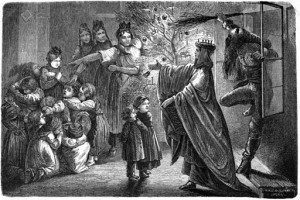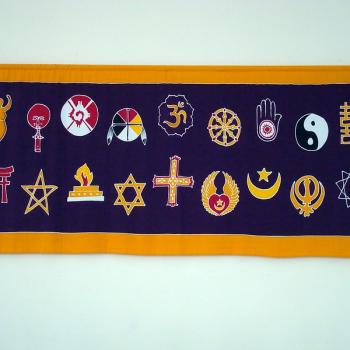I n a review of what sounds like an excellent book on Bach’s Christmas Oratorio, Nathaniel Peters quotes a 17th century theologian on what Christmas was like under Medieval and 17th century Catholicism.
n a review of what sounds like an excellent book on Bach’s Christmas Oratorio, Nathaniel Peters quotes a 17th century theologian on what Christmas was like under Medieval and 17th century Catholicism.
He describes the processions, featuring actors dressed up like the Christ Child, St. Peter, other saints, angels, and “damned spirits,” including the terrifying Knecht Ruprecht (who became a companion of St. Nicholas). The goal was to scare children out of their wits. The Christ Child would berate the kids for their sins and threaten to punish them. Then St. Peter and the saints intercede for them. Then Jesus gives them presents.
Notice how Jesus is all about the Law, not the Gospel. The saints are the intercessors. But at least the children get gifts eventually. (St. Nicholas is described as being in the company of saints who scare the children. He has become rather more a figure of grace today, giving gifts without conditions.)
You’ve got to read Johann Gabriel Drechssler’s 1674 account after the jump.
From Nathaniel Peters, Christ’s Three-Fold Coming in Music | First Things, quoting Johann Gabriel Drechssler (1674):
Long before [Christmas] masked persons run around with jingling bells, pretending to be a servant of the Holy Christ, Saint Martin or Nicholas, scare the children, admonish them to pray, and give them little gifts. When Christmas draws nearer, the number of crazy spirits increases until finally on Christmas Eve the whole heavenly host (which is probably sent out by the black bogeyman) fills the streets. Then one enacts the newborn Jesus, the Holy Christ, ornate with crown, scepter, and beard, as if the dear Christ-Child had come into the world that way. He is accompanied by angels, St. Peter with the key, other apostles, then several Ruprechts or damned spirits.
Such a holy company is led in front of little children, who are nearly dead of fear. The arch-villain, Knecht Ruprecht, begins accusing them. The Holy Christ, being upset, wants to go; however, the angel Gabriel as well as Peter and the other companions intercede and placate the Holy Christ, after which he makes them bring in plenty of gifts and promises mercy and kindness to the little idols. The little children, who were cheated, are meanwhile full of devotion which is directed toward this visible mercy. The Holy Child is worshipped with prayers because of the gifts; the surrounding saints because of their intercessions; and Ruprecht because of the mercy and only light punishment.
[Keep reading. . .]
It looks like Knecht Ruprecht remained a companion of St. Nicholas in Germany and other countries even in some places today. He is a sort of anti-Santa Claus. Do any of you know if versions of Knecht Ruprecht and this procession could be found in Lutheran regions? If so, surely this version of the punishing Christ-child and the intercession of the saints surely wasn’t part of it. Was it?
 n a review of what sounds like an excellent book on Bach’s Christmas Oratorio, Nathaniel Peters quotes a 17th century theologian on what Christmas was like under Medieval and 17th century Catholicism.
n a review of what sounds like an excellent book on Bach’s Christmas Oratorio, Nathaniel Peters quotes a 17th century theologian on what Christmas was like under Medieval and 17th century Catholicism.













